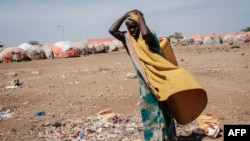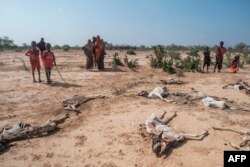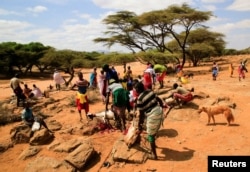The East African bloc IGAD, aid groups, and development partners have called for greater coordination to fight growing hunger in the region.
An estimated 51 million people across East Africa are in dire need of food, water and medicine. Ministers from the eight nations of IGAD — the Intergovernmental Authority on Development — met in Nairobi this week to find ways to deal with the general humanitarian crisis in the region.
The World Food Program's regional director for Eastern Africa, Michael Dunford, said urgent action is needed.
"As indicated, we are in crisis and it's not just a food crisis, it's a water crisis, it's an education crisis, it's a livelihood crisis, it's a nutrition crisis," he said. "And over the last couple of days, we have had many words spoken but now we need to turn these words into actions and actions where we joined up, able to respond to the needs of the population across the Horn of Africa."
The WFP says its annual needs for the region have climbed from $4.3 billion to $6 billion and, despite getting some donations, it has yet to close the gap.
Persistent drought made worse by four consecutive failed rainy seasons has wiped out crops and livestock in the region, destroying the livelihoods of millions in the Horn of Africa.
Mohamed Malick, regional director for Eastern and Southern Africa for the United Nations children's agency, or UNICEF, said the region is losing its younger generations due to lack of food and water.
"Malnutrition figures are skyrocketing. We know as we speak today there are 1.7 million children who are facing severe and acute malnutrition, which is an extreme form of malnutrition and a major cause of death," he said. "As we speak today, children are having problems accessing water."
UNICEF says at least 3.7 million students in the region may have dropped out of school and most of them may not return to class.
Somalia is one of the countries most affected by the drought, with more than seven million people who are food insecure.
The country's minister for agriculture and irrigation, Ahmed Madobe Nunow, said conflict and lack of government presence in many parts of Somalia have made it difficult for people to feed themselves.
"Land access and utilization is a challenge in Somalia, because most of the fertile land is not in the hands of the government and, therefore, land access is an additional problem in Somalia," Nunow said.
In neighboring Ethiopia and Kenya, at least 23 million people are food insecure and, in Ethiopia, conflict in the Tigray region has worsened the humanitarian situation.
According to the aid agencies, six million South Sudanese are food insecure, and 30 percent of Sudan's population is facing a food crisis compounded by climate change, political instability and increased food prices.
Sudan's minister for agriculture and forest, Abubakr Omer Elbushra, said a population in constant conflict and violence cannot produce sufficient food.
"In stable communities, [people] who are affected by tribal or political crises turn to either refugees or displaced. People in camps lose their livelihood. They are changed from producers to consumers and here, a food crisis strikes," Elbushra said.
Government representatives and aid agencies are calling for coordinated regional interventions, strengthening of research capacities, and early warning systems to prevent disasters related to food and nutrition crises before they happen.










